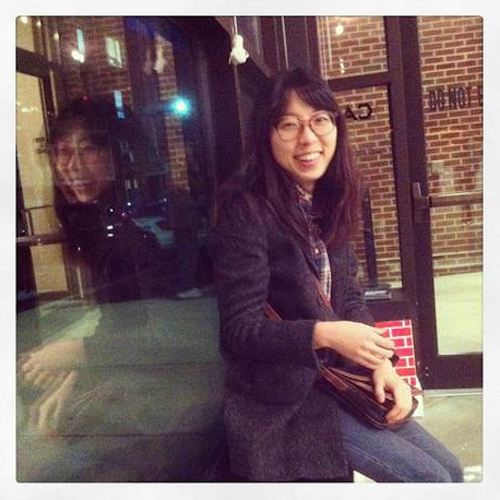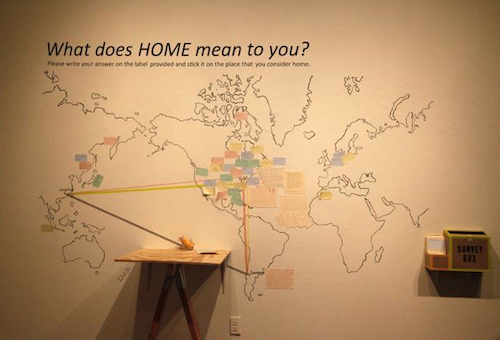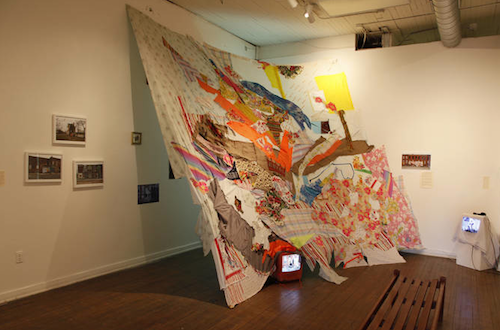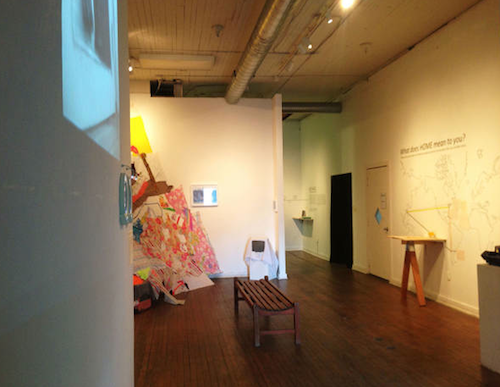Personal ritual, family, food, place, safety, shelter, and a sense of belonging are both tangible and intangible universal elements of home. ‘Exchange: A Home Based Residency,’ created by Hyejung Jang, on exhibit at School 33, was an experimental effort to bridge the gap between artists and the greater community. Providing two international emerging artists the opportunity to replant themselves with a family in Baltimore for two months, they were given the challenge to engage their hosts and the public in their practice.
Elisa Garcia de la Huerta, an interdisciplinary artist from Chile living in NYC, was hosted by Beth Frederick and Don Palmer in their Bolton Hill home. Kityi Wong, an experimental artist from Hong Kong, also living in NYC, was hosted by Steve Freel in Station North. The artists made a space for themselves within the home of their hosts, created a new studio, and learned the rhythm of a new city for eight weeks removed from their American homes, as well as their homes of origin in geography and language. They immersed themselves in reaching inward and outward for resources and inspiration to create a new, meaningful body of work.
Hyejung Jang is pursuing a curatorial specialization in socially engaged art. With a unique educational background that affords her multiple perspectives, Jang holds bachelors degrees in both studio art from Sungkyunkwan University in Seoul, Korea, and art history from Hunter College in New York City. She is an 2013 MFA candidate in Curatorial Practice at MICA. She believes that the curator is responsible for delivering art and making it relevant for society, bringing art closer to the audience.
Jang plans to use her skills as both a curator and an educator to provide opportunities for emerging artists, not only within the framework of exhibitions, but in community engagement. With ‘Exchange,’ Jang was able to bring her vision to life in her thesis work this spring, having worked to plan it for the past two years. In evaluating the success and complexities of the residency she designed, considering multiple variables is exciting, and she hopes to repeat the project in the future. There were multiple access points for public involvement and interest throughout the project including social media outreach, a Kickstarter fundraising campaign, public programming, and an interactive map in the culminating final exhibit at School 33 Art Center in Federal Hill.
Socially engaged art typically tackles contemporary political issues, and tends to depend heavily on documentation in a gallery setting. The artist is the facilitator of civic dialogue through reciprocal relationships, and participatory art-making about pressing contemporary issues. In Exchange, the practice is intimate, a personal response to a place, and a focus on interpersonal relationships. Socially engaged art practice is evolving and somewhat challenging to pinpoint with varying criteria by art critics such as Grant Kester and Claire Bishop, as well as Education for Socially Engaged Art, a book by Pablo Helguera.
In response, Jang writes, “Socially engaged art often struggles to achieve sustainability, and the gap between the art world and the community at large persists after the project is completed.” This project expands the notion of socially engaged art and drives it directly to the core: home and family. The relationships formed, and the positive experience with contemporary art is meant to encourage future engagement, for the participants and their networks. Socially engaged art typically exists within artist collectives and individual practices, not created purely from a curator’s point of view. According to Jang, Exchange pioneers “new ways of fostering a sense of interconnectedness through the art, supporting emerging artists, and stimulating dialogue about contemporary art in everyday life.”
While inviting international artists to participate was not a primary parameter for the exchange project, it evolved because of Jang’s personal connection of being an international student. Her interest in creating an intimate interaction between host families and artists, who already have had experience and relative success in adapting to a new culture and language, challenged the notion of home and family. She wanted to support emerging international artists by providing an opportunity to present their work and consider their role as an artist in society. She imagined a reciprocal benefit to both artist and host, the artist and non-arts community, and unexpectedly to the partnering institutions. Jang is interested in how artists can interact together, and with the greater community. In a relatively high stakes experiment, the balance was carefully weighed between structure and the organic unfolding and openness of both the process and final exhibition.
From home, where do you go? To school, but of course. Cleverly, Jang partnered with School 33 Art Center to generously provide the artists with studio and gallery space. Exhibitions Coordinator, Rene Trevino noted that these were the first international artists in residence at School 33. Jang carefully chose host families who did not consider themselves part of the arts community, but were interested in learning firsthand about contemporary art, and who were located within easy reach of public transportation.
Both artists took advantage of the Charm City Circulator to get from their Bolton Hill and Station North homes down to Federal Hill. This contributed to the structure of the residency, including programming a conversation to a selected group of individuals in the arts community, and open studio with the public. The host families participated in the open studio, acting as docents to engage with visitors about the project and the concepts behind the work.
Jang created a website to document the unfolding relationships, and multiple aspects of the residency. All participants were asked to keep a journal of their experiences. As the curator and facilitator, Jang was instrumental in coordinating and inviting the artists to take advantage of the many opportunities at MICA, including visiting artist lectures and utilizing video equipment. The design of the residency also imparted the curator’s unique definition of home. Artists and hosts were asked to share meals together weekly as a way to encourage conversation, sharing ethnic cuisine, and aspects of daily life. Don Palmer and Beth Frederick formed a particularly special relationship with Elisa Garcia de la Huerta.
Both artists collaborated with one or more members of the greater community through open call requests. Kityi Wong posted flyers looking for people whose cats would be willing to explore a new environment in another person’s home. Attaching a video recording device to two cats, the viewer hilariously sees the motion and activity at cat’s eye level. She also called for a willing participant to float and chat with her in a boat she created. Wong addresses issues of chance meeting and intimacy through conversation, and challenges comfort levels between strangers in a very physical way. The conversation and experience were videotaped and is on exhibit as well as the boat built for two.
Elisa Garcia de la Huerta posted flyers for a Freestyle Quilt Gathering, in which I participated, collaborating on a large quilt titled “Dwelling. Gathering Stitches.” She also created ephemeral outdoor fabric interventions, layering colorful pieces of cloth over doorways and windows of a dozen abandoned rowhomes in Baltimore city. Both of these sets of work challenge the notion of authorship in their collaborative nature. In addition to the title labels, both artist and host have text elaborating on their experience of each piece. An interactive map encourages viewers to write about their ideas about home and attach them to the map, marking the geographic location of their home.
‘Exchange: A Home Based Residency’ was a rich, memorable experience for both artists, curator, hosts, and collaborators. The many layers of interaction, relationships, and story are woven into the work in the exhibit. An interpersonal approach to socially engaged practice addressed themes in contemporary art creating accessible opportunities for conversation, artmaking, and exhibition, giving the artist and public a framework and place to interact.
Exchange: A Home Based Residency, work by Elisa Garcia de la Huerta and Kityi Wong, curated by Hyejung Jang, MFA candidate in Curatorial Practice at MICA, is on view at School 33 Art Center in the second floor Member’s Gallery until May 25th.
Author Jill Gordon is an urban explorer, artist, and writer. She is a member of Mother Made Baltimore, and can be contacted at [email protected].










